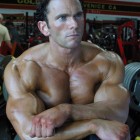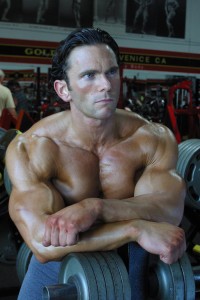
 If you workout long enough it is bound to happen no matter how careful you are with your execution. A strain here, a pull there or possibly worse. What should you do when you get an ache or pain?
If you workout long enough it is bound to happen no matter how careful you are with your execution. A strain here, a pull there or possibly worse. What should you do when you get an ache or pain?
First let me start by saying forget about the archaic notion of “no pain, no gain”. The pain is there for a reason and it is telling you “stop doing this motion, stupid!” If you ignore the pain and try to work through it you are setting yourself up to make the problem worse or at minimum prolong the healing process. You could turn a minor pain into a major problem real quick if you are not careful.
When you have an area that is in pain you need to work around the injury by selecting exercises that cause little to no aggravation. Under these circumstances it is OK to choose exercises even if they fall out of the Max-OT guidelines. If you find a movement that doesn’t cause pain proceed with caution and focus on form and feel rather than pushing maximal weight.
If the area hurts no matter which alternative exercise you try you need to take time off and let the area heal. You have nothing to gain by trying to push through the pain.
Continue to train other body parts that don’t affect the area and let the injury heal. It is better to take a week or two off rather than make the problem worse and have to deal with it for 6 months or more.
If you train smart and work around pain rather than ignoring it you will be back to lifting maximal weights in no time.




Jeff,
Very motivated now more than ever, since my son showed me the documentery. I have gone to the gym here and there, or just get flat out lazy. And feel pain where I never have before when I do go with my son. I think my son is putting me threw the mill. Do you have something for beginners and good proper diet that can pair the two togather. I’m 170, 37 years young, thin framed and a small gut. I would like to add mass, loose the gut. And just look great, not for competition, but for myself.
I recommend either the MASS Pack or the “I Want to Look Like That Guy” SYSTEM. Both value packs include a lot of great information about the Max-OT principles as well as important nutrition basics. The SYSTEM has 7 DVD’s in one pack and encompasses all the philosophies I personally used and the same methods I instructed Stu to use in his transformation.
Hi Jeff,
If I may ask a question unrelated to injury prevention.
I recently had a discussion about the differences in rep ranges to achieve strength and muscle growth. Many people that low rep ranges from as low as 1-3reps per set cannot simply stimulate growth, only strength gains. Since discovering Max-OT training, my argument would be that as long as progression occurs, there must be an increase in both strength and muscle gain. In other words, if the weight one lifts, even for 1-3 reps, increases, surely gains in both strength and muscle must be taking place. Imean strongmen often train using reps as low as 1-3 per set and they gain both strength and muscle. While i am not advocating extremely low reps, I think they can be effective for both gains in muscle and strength. Am I missing something?
No, I don’t think you are missing anything.
Hi Jeff!
I’m from sweden and I have a question about food. Some time ago I read on the AST sports site about food, I think it was your good friend Paul Delia who wrote the article.
Anyhow he said that during the day you should eat carbs from the lower GI scale and then after training the body wants food from the higher GI scale like white rice as I recall.
My question is, for some time now I have been eaten meat with redsauce and wholemeal pasta if you know what that is? For lunch. It’s pasta that’s from lower GI scale with fiber in it. The reason Im doing this is because he(Paul) wrote about the importance about controlling your glucose input or how you want to call it. Keeping it on a firm level through out the day. Is this something you would recommend or not? Because I’ve heard that fiber is not good for muscular development. And if not is there any other source of lower GI scale food you would recommend instead?
Also I just want to say your doing an awesome work! Your an inspiration to us all! Keep it up!
With best regards Rickard.
I agree that in the non training hours you want low GI carbohydrates just as Paul advocates. I think fiber in the diet is a good thing and I don’t know of any adverse effects towards muscle building. I think it is the contrary.
I came across this article today and was slightly surprised to see that massage therapy was not mentioned in it. I have personally had great results with eliminating any pulled or strained muscles by using massage therapy on a consistent basis.
Just as you said, eventually I ended up straining a muscle and it would not go away, even with rest. I wasn’t sure about trying massage therapy at first on account of the high price, but in the end it was completely worth it. 2-3 sessions, fixed most of my pulled muscles, and now that I am getting them regularly most of my strains are gone in 1 session.
I also noticed chiropractics has done a lot for me. I did some heavy lifting outside of the gym, then would go to the gym and lift afterwards (like an idiot) and eventually hurt my hip. Took me almost two years before I saw a chiropractor and found out my entire hip alignment was out of place. Within one adjustment I was already feeling 60% better.
Was curious how you felt about these methods of healing injuries.
I think both chiropractic and massage are excellent.
Hey Jeff,
I recently got a little careless with my at the end of a session when I was doing shoulders and pulled either my trap or rhomboid muscle on my right side. I’m in a decent amount of pain to the point where sleeping has been tough due to discomfort but I would like to continue to work around the injury. Any recommendations on what I could due without further injury my upper back? Thanks!
You have to be careful and really listen to the pain. Avoid movements that cause any aggravation. If all movements cause pain then you may have to take time off until you can do exercises pain free. Massage and/or Chiropractic care could be helpful as well. Don’t ignore the pain and try to work through it as you risk making things much worse. It’s better to miss a few workouts rather than a few months!